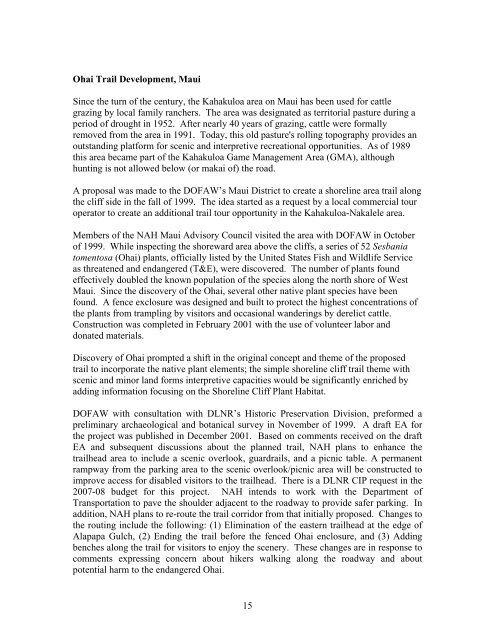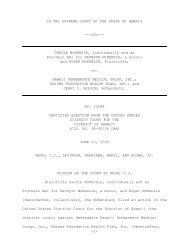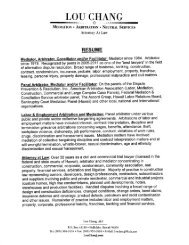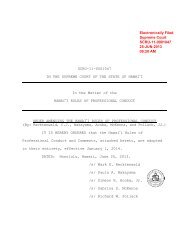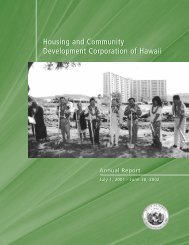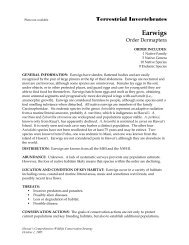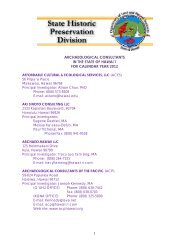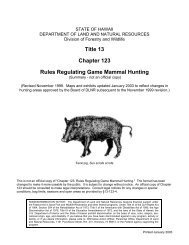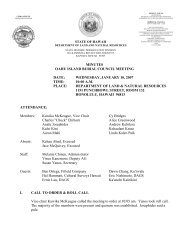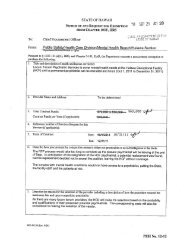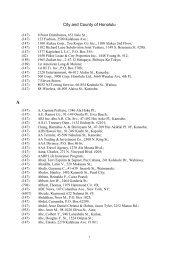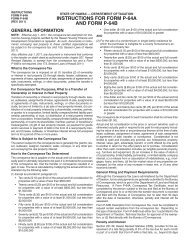Na Ala Hele Trail and Access Program
Na Ala Hele Trail and Access Program
Na Ala Hele Trail and Access Program
Create successful ePaper yourself
Turn your PDF publications into a flip-book with our unique Google optimized e-Paper software.
Ohai <strong>Trail</strong> Development, Maui<br />
Since the turn of the century, the Kahakuloa area on Maui has been used for cattle<br />
grazing by local family ranchers. The area was designated as territorial pasture during a<br />
period of drought in 1952. After nearly 40 years of grazing, cattle were formally<br />
removed from the area in 1991. Today, this old pasture's rolling topography provides an<br />
outst<strong>and</strong>ing platform for scenic <strong>and</strong> interpretive recreational opportunities. As of 1989<br />
this area became part of the Kahakuloa Game Management Area (GMA), although<br />
hunting is not allowed below (or makai of) the road.<br />
A proposal was made to the DOFAW’s Maui District to create a shoreline area trail along<br />
the cliff side in the fall of 1999. The idea started as a request by a local commercial tour<br />
operator to create an additional trail tour opportunity in the Kahakuloa-<strong>Na</strong>kalele area.<br />
Members of the NAH Maui Advisory Council visited the area with DOFAW in October<br />
of 1999. While inspecting the shoreward area above the cliffs, a series of 52 Sesbania<br />
tomentosa (Ohai) plants, officially listed by the United States Fish <strong>and</strong> Wildlife Service<br />
as threatened <strong>and</strong> endangered (T&E), were discovered. The number of plants found<br />
effectively doubled the known population of the species along the north shore of West<br />
Maui. Since the discovery of the Ohai, several other native plant species have been<br />
found. A fence exclosure was designed <strong>and</strong> built to protect the highest concentrations of<br />
the plants from trampling by visitors <strong>and</strong> occasional w<strong>and</strong>erings by derelict cattle.<br />
Construction was completed in February 2001 with the use of volunteer labor <strong>and</strong><br />
donated materials.<br />
Discovery of Ohai prompted a shift in the original concept <strong>and</strong> theme of the proposed<br />
trail to incorporate the native plant elements; the simple shoreline cliff trail theme with<br />
scenic <strong>and</strong> minor l<strong>and</strong> forms interpretive capacities would be significantly enriched by<br />
adding information focusing on the Shoreline Cliff Plant Habitat.<br />
DOFAW with consultation with DLNR’s Historic Preservation Division, preformed a<br />
preliminary archaeological <strong>and</strong> botanical survey in November of 1999. A draft EA for<br />
the project was published in December 2001. Based on comments received on the draft<br />
EA <strong>and</strong> subsequent discussions about the planned trail, NAH plans to enhance the<br />
trailhead area to include a scenic overlook, guardrails, <strong>and</strong> a picnic table. A permanent<br />
rampway from the parking area to the scenic overlook/picnic area will be constructed to<br />
improve access for disabled visitors to the trailhead. There is a DLNR CIP request in the<br />
2007-08 budget for this project. NAH intends to work with the Department of<br />
Transportation to pave the shoulder adjacent to the roadway to provide safer parking. In<br />
addition, NAH plans to re-route the trail corridor from that initially proposed. Changes to<br />
the routing include the following: (1) Elimination of the eastern trailhead at the edge of<br />
<strong>Ala</strong>papa Gulch, (2) Ending the trail before the fenced Ohai enclosure, <strong>and</strong> (3) Adding<br />
benches along the trail for visitors to enjoy the scenery. These changes are in response to<br />
comments expressing concern about hikers walking along the roadway <strong>and</strong> about<br />
potential harm to the endangered Ohai.<br />
15


